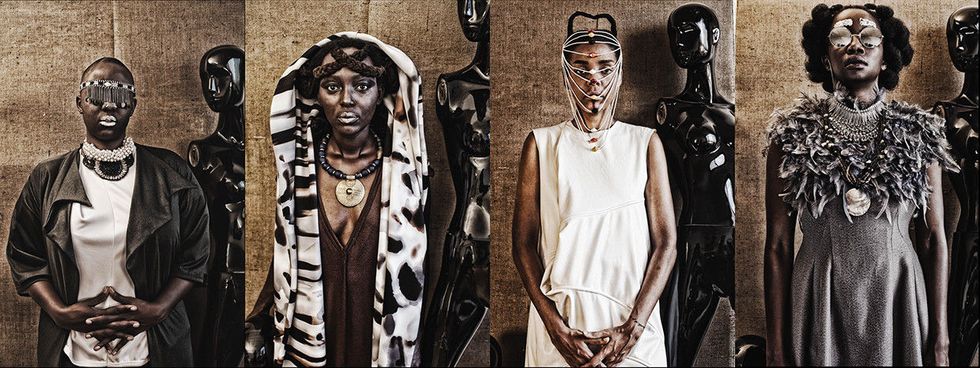How The Salooni Project Has Created a Safe Space for African Women to Love Their Hair
Through their pop-up salon art installation, four Ugandan creatives imagine a future where Afro-textured hair is no longer a painful subject for Black women.

Outside a TV monitor plays a tutorial on how to survive a white supremacist hairstyle. Passing through a cascading beaded curtain, you’re greeted by a full set of sprays—aloe and other oils—and three comfortable chairs. A projection on the wall shows a loop of traditional and contemporary Afro-textured hairstyles, including a Mohawk dating back to the 1950s.
Welcome to The Salooni Project, a conceptual art installation, created by Ugandan friends Kampire Bahana, a writer-organizer; Darlyne Komukama, a photographer; Aida Mbowa, a theater buff; and Gloria Wavamunno, a fashion designer. Together, they’ve taken their pop-up salon experience on the road to festivals like LaBa! Arts Festival in Kampala and Chale Wote Art Festivalin Accra.
“It is an attempt to imagine a space and a future in which Black hair issues are elevated to a culture and a science, a site of knowledge,” Kampire explains over Skype. “But it is not as fraught and painful a subject and an experience for Black women.”

Beyond recreating the familiar, communal Black salon—or “salooni” as it’s called in Uganda—experience (or what’s become a ritual for many Black women), the project invites patrons to sit down for a free massage, hair play or in some cases, a big chop. Your experience varies depending on which chair you choose. It’s a “gesture of care for the public in a non-judgmental and anonymous way,” Aida tells Okayafrica.
Through exhaustive research culled from video tutorials, Black beauty and hair Instagrams and Tumblr pages, photography by J.D. 'Okhai Ojeikere and Shani Crowe (a strong muse), and books and articles such as “Black Hairstyle Politics” by Kobena Mercer, the creators have aimed to elevate Black women’s knowledge of hair practices and rituals of care—like memories of sitting between your loved one’s legs as she molds your hair into Bantu knots or oils your scalp before bed—while guiding festival-goers to a safe space where they can "really reckon with what [their] hair looks like when it grows out of [their] head,” Aida posits. “I think this a powerful move forward for so many of us.”
Their findings and The Salooni Project reveal that more needs to be done to transcend Hotep information, or as Kampire defines as “a poorly educated, overly Pan-Africanist, sort of mystical, spiritual history or practice or knowledge,” that tends to supplant the topic of Black women’s hair on the internet, so that they can arrive at a truly free future where “hair is an expression of the full degree of their freedom no matter what that looks like,” Aida says.

And you don’t have to be natural to partake either, as Kampire and Aida make clear, “everyone is welcome.”
“We live in a world that is structured in a certain way. To place that blame on people who are just getting through the day or doing what they have to do to win that job interview or whatever seems very unfair to me and something that we very much wanted to avoid doing ourselves,” Kampire explains.
Furthermore, The Salooni Project represents a journey through the historical understanding of the ways in which Black women have imparted survivalist strategies, often “conforming to mainstream beauty standards,” handed down from generation to generation.
“Your ability to make a round, soft ball is, to be honest, a function of having white blood in you. It will allow that fabulous Angela Davis Afro. We on the continent can’t have those aspirations for our hair because we will just be disappointed,” Aida says. “Because when you walk around villages in Africa and see girls with long hair, it’s still not going to look like Angela Davis’ hair. It’s just not.”
Part of desiring a loose Angela Davis ‘fro speaks to the conundrum that Afro-textured hair has long been politicized and policed as Black women find themselves at the intersection of oppression, coined "misogynoir" by queer Black feminist scholar Moya Bailey.
And in Uganda, Kampire and Aida point out, this misogynoir plays out in public and private schools via policies that dictate that Black students aren’t allowed to grow their hair because it’s “seen as an expression...that you are un-tamable,” Aida explains.
“Uganda is a pretty conservative society so if you don't look smart, if you don't look like you care for appearance and look very neat and have a colonial-prescribed appearance even in 2016, that [means] to a certain extent you don't fit in,” Kampire adds.
These discriminatory policies—not limited to Uganda—came to a head in South Africa last month with natural hair protests at Pretoria High School for Girls, where Kampire’s cousin was an alumnae, as well as at Lawson Brown High School.
“I never thought that I would see a day in which we confront some of these ideals like colonial hair policies which go about unquestioned and unthought about in Uganda,” Kampire says. “I really thought we would just continue with this assumption and maybe my kids would be smart enough and politically conscious enough to challenge some of these ideas.”

“I think it is incredible girls [that] young are so able, are so empowered and strong enough to stand up to the systems, Aida adds.
Similarly dispelling those negative notions about Afro-textured hair—instilled by systematic white supremacy, specifically colonialism on the African continent—is part of the intention of The Salooni Project, which as Kampire suggests, “is the first experience for a lot of Black women to walk into a hair salon and not be yelled at and told that something is wrong with their hair.”
And if we can ever arrive at this idealized future, Aida offers, “We will see things we have never seen before and we will see things we have seen many times—and that will be just fine.”

